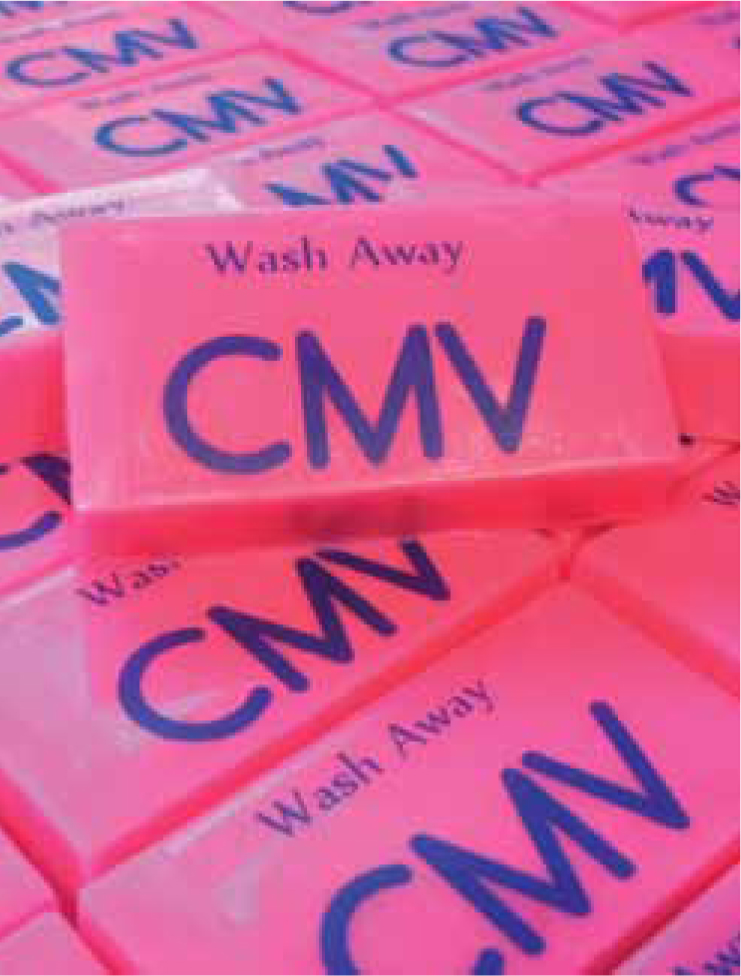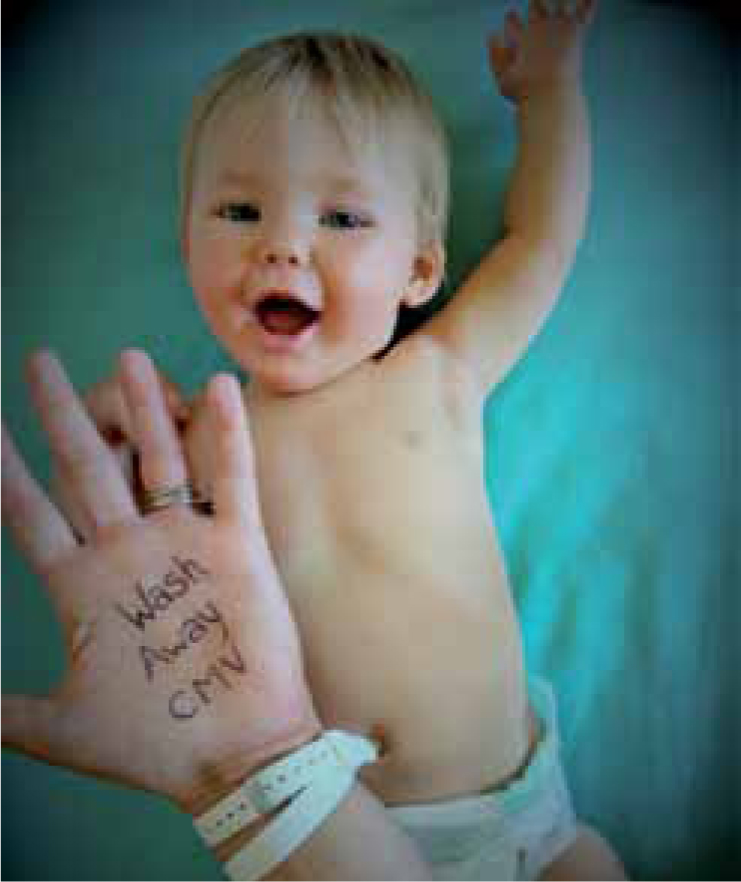In June, newly-formed charity CMV Action held its inaugural awareness month. Although charity awareness months are commonplace these days, cytomegalovirus (CMV) definitely needs its profile raising. Despite the fact that CMV affects 1 in 1000 babies in the UK, very few pregnant women seem to have heard about it and, more worryingly, its damaging potential. Caroline Star, chair of CMV Action, outlines why she believes every pregnant woman should know about the virus and some basic hygiene precautions they can take to reduce their risks.
What is CMV?
CMV is a common virus that can infect anyone at any age. Once caught, CMV is with a person for life. It is unlikely that a healthy person will experience any signs or symptoms or any long-term effects from CMV. However, it can be very dangerous to unborn babies.
Is congenital CMV a rare condition?
CMV is the most common infection at birth. Around 1 in 1000 babies born in the UK will be affected by CMV—almost 1000 babies every year (Griffiths et al, 1991; Dollard et al, 2007). As CMV is relatively unheard of, it is a common misconception that it is rare. However, it is more common than Down Syndrome, Toxoplasmosis, Spina Bifida and Rubella (Griffiths et al 1991; Dollard et al, 2007; Cannon, 2009; NHS Choices, 2014).
How long have we known about it?
CMV was discovered in 1958 by the same scientists who discovered the likes of rubella and measles: viruses that are now easily controlled, thanks to effective vaccine programmes. Unfortunately, a vaccine is not yet available for CMV, although research into vaccination as well as treatment in pregnancy is in progress.

The absence of treatment options may be one of the reasons health professionals are hesitant to warn pregnant women about the risks of CMV. A survey of over 1000 British women aged 18-44 years, showed that only one third of women of childbearing age in Great Britain have heard of CMV (33%) and only 14% know what it is (ComRes, 2014), even though it is more than 30 times as common as toxoplasmosis or listeria (Griffiths et al, 1991; Dollard et al, 2007). It is standard practice to advise women about the risks of these infections and many pregnant women take special care to avoid cat litter trays or soft cheese as a result. The same research established that 9 out of 10 women (91%) think that pregnant women should be given advice about CMV infection during pregnancy (ComRes, 2014).
How do people catch CMV?
CMV is spread from one person to another by close and prolonged contact with bodily fluids such as urine, saliva, tears, breast milk, semen and cervical secretions. Thus CMV can be caught by kissing, through sexual intercourse, sharing cutlery, glasses, food etc. and by touching toys a child has put in its mouth and then putting that hand to mouth.
Many small children catch CMV, especially those who attend nurseries. Exposure to urine and saliva of small children is the main reason pregnant women catch CMV. Women who work with children or who have a family therefore need to be especially careful during pregnancy. This is a risk very specific to CMV that pregnant women need to know about.
How can pregnant women reduce their risk of catching it?
The NHS advises that pregnant women can take the following steps to reduce their risk of catching CMV (NHS Choices, 2012):
The CMV Action survey shows that in the UK, women of childbearing age want to know more about CMV; more than 7 in 10 women would be prepared to change their behaviour and take each of the recommended measures to prevent CMV during pregnancy, such as not sharing their babies' dummies and their cutlery and food with anyone or washing their hands more regularly. The survey also found that women want this advice from a health professional (ComRes, 2014).
Three-quarters of British women of child-bearing age (75%) said that they would value the advice from a midwife about whether or not to take preventative measures to reduce their risk of CMV infection during pregnancy. A short conversation with a midwife could save a baby's life or protect it from a lifetime of suffering. Evidence from small-scale international studies suggests that education interventions for pregnant women can reduce the risk of catching CMV in pregnancy by 50–85% (Adler et al, 2004; Vauloup-Fellous et al, 2009).
What about health professionals?
Christine Wheatley is a GP from Hampshire. Before having her second child, she didn't talk to her pregnant patients about CMV. That changed when her daughter, Ellie, was born profoundly deaf and with feeding and sleeping problems as a result of contracting CMV in utero. Christine now takes a couple of minutes to tell pregnant women about the hygiene precautions they should take and feels that women who work with children, or who already have small children at home, are at greater risk of contracting CMV during pregnancy.
She believes a mention of CMV, and ways to prevent catching it, could, and should, be given quickly and without alarm by GPs or midwives. As she sets out: ‘CMV is a devastating illness, both personally and in terms of the future cost to the state. I dread to think what Ellie has cost the NHS and education services in her 6 short years!’
What does the future hold?
Paul Griffiths, Professor of Virology at the Royal Free Hospital and University College has spent his professional life in medical virology. He is a leading authority on the CMV virus and is helping to lead the drive in this country to find an effective vaccine to ultimately eradicate it. Recent clinical trials report that protection is a distinct possibility and several vaccine candidates are now being evaluated.
‘After decades of counselling pregnant women with CMV infection about their individual risks of having a baby damaged by this virus, I still have difficulty answering their questions such as why they hadn't been told about the infection before and why there isn't a vaccine. For too long CMV has flown under the radar because it does not often produce overt symptoms to declare its presence.’
It is possible that CMV immunisation may become a routine part of clinical care for women of childbearing age in the next 10 years. However Paul feels more can and should be done right now: ‘More information should be made available to pregnant women. Especially for those women who already have young children, and whose exposure to CMV is more likely due to lifestyle, and contact with other youngsters and families. CMV Action is playing a vital role in supporting this.’

The ultimate guide to hand-washing
The CMV virus is easily killed by soap and water. Hand-washing is one of the most effective ways to avoid infection—by washing the virus away and by deactivating it.
Step one
Remove any jewellery. Wet your hands thoroughly first to stop the soap drying out your skin. Lather your hands with soap under a running tap using warm water. Plain soap gets rid of the CMV virus as effectively as anti-bacterial soap (Stowell et al, 2014).
Step two
Vigorously rub your hands together. Make sure you include the backs of your hands, your wrists and in between your fingers as well as under your nails too. Do this by interlocking your hands and using the nails on one hand to clean under those on the other. Make sure you also wash your thumbs.
Step three
You should wash your hands for at least 20 seconds—if you sing ‘happy birthday’ to yourself three times, this should do the trick. Probably better to sing this to yourself in your head if you're washing your hands in public.
Step four
Make sure you rinse your hands thoroughly. Start at your wrists and let the water run down your hands and off the tips of your fingers. After that, carry on rinsing your hands, almost as if you were washing them again, but without the soap.
Step five
Dry your hands using a hand dryer, or paper towels. Almost repeat the procedure of washing your hands with the paper towel as this will get rid of remaining virus. If possible, use a paper towel to turn the tap off to avoid touching it with your clean hands.
What if you can't get to a sink
If you cannot get to a sink, then alcohol-based hand sanitiser is a good alternative. Make sure it contains at least 60% alcohol and use lots of it. While it won't completely remove the CMV virus, it will render it non-viable. Wet-wipes are not effective at removing or de-activating CMV (Stowell et al, 2014).
Find out more
You can download CMV Action's education leaflet from www.cmvaction.org.uk or order copies from info@cmvaction.org.uk.

